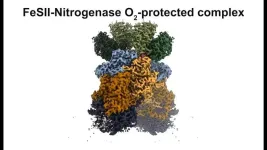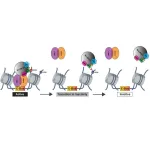(Press-News.org) PROVIDENCE, R.I. [Brown University] — Amid the many mysteries of quantum physics, subatomic particles don’t always follow the rules of the physical world. They can exist in two places at once, pass through solid barriers and even communicate across vast distances instantaneously. These behaviors may seem impossible, but in the quantum realm, scientists are exploring an array properties once thought impossible.
In a new study, physicists at Brown University have now observed a novel class of quantum particles called fractional excitons, which behave in unexpected ways and could significantly expand scientists’ understanding of the quantum realm.
“Our findings point toward an entirely new class of quantum particles that carry no overall charge but follow unique quantum statistics,” said Jia Li, an associate professor of physics at Brown. “The most exciting part is that this discovery unlocks a range of novel quantum phases of matter, presenting a new frontier for future research, deepening our understanding of fundamental physics, and even opening up new possibilities in quantum computation.”
Along with Li, the research was carried out by three graduate students — Naiyuan Zhang, Ron Nguyen and Navketan Batra — and Dima Feldman, a professor of physics at Brown. Zhang, Nguyen and Batra are co-first authors of the paper, which was published in Nature on Wednesday, Jan. 8.
The team’s discovery centers around a phenomenon known as the fractional quantum Hall effect, which builds on the classical Hall effect, where a magnetic field is applied to a material with an electric current to create a sideways voltage. The quantum Hall effect, occurring at extremely low temperatures and high magnetic fields, shows that this sideways voltage increases in clear, separate jumps. In the fractional quantum Hall effect, these steps become even more peculiar, increasing by only fractional amounts — carrying a fraction of an electron's charge.
In their experiments, the researchers built a structure with two thin layers of graphene, a two-dimensional nanomaterial, separated by an insulating crystal of hexagonal boron nitride. This setup allowed them to carefully control the movement of electrical charges. It also allowed them to generate particles known as excitons, which are formed by combining an electron and the absence of an electron known as a hole. They then exposed the system to incredibly strong magnetic fields that are millions of times stronger than Earth's. This helped the team observe the novel fractional excitons, which showed an unusual set of behaviors.
Fundamental particles typically fall into two categories. Bosons are particles that can share the same quantum state, meaning many of them can exist together without restrictions. Fermions, on the other hand, follow what’s known as the Pauli exclusion principle, which says no two fermions can occupy the same quantum state.
The fractional excitons observed in the experiment, however, didn’t fit cleanly into either category. While they had the fractional charges expected in the experiment, their behavior showed tendencies of both bosons and fermions, acting almost like a hybrid of the two. That made them more like anyons, a particle type that sits between fermions and bosons — yet the fractional excitons had unique properties that set them apart from anyons, as well.
“This unexpected behavior suggests fractional excitons could represent an entirely new class of particles with unique quantum properties,” Zhang said. “We show that excitons can exist in the fractional quantum Hall regime and that some of these excitons arise from the pairing of fractionally charged particles, creating fractional excitons that don’t behave like bosons.”
The existence of a new class of particles could one day help improve the way information is stored and manipulated at the quantum level, leading to faster and more reliable quantum computers, the team noted.
“We’ve essentially unlocked a new dimension for exploring and manipulating this phenomenon, and we’re only beginning to scratch the surface,” Li said. “This is the first time we’ve shown that these types of particles exist experimentally, and now we are delving deeper into what might come from them.”
The team’s next steps will involve studying how these fractional excitons interact and whether their behavior can be controlled.
"This feels like we have our finger right on the knob of quantum mechanics,” Feldman said. “It's an aspect of quantum mechanics that we didn't know about or, at least, we didn't appreciate before now.”
END
Discovery of new class of particles could take quantum mechanics one step further
A study led by a team of Brown University researchers could lead to new ways of exploring quantum phenomena, with implications for future advances in technology and computing
2025-01-08
ELSE PRESS RELEASES FROM THIS DATE:
Cost-effectiveness of a polypill for cardiovascular disease prevention in an underserved population
2025-01-08
About The Study: The results of this economic evaluation suggest that cardiovascular polypill treatment (single pill containing a statin and 3 half-standard dose antihypertensives) could be a high value intervention for a low-income, majority Black population with limited access to health care services. It could additionally reduce health disparities.
Corresponding Author: To contact the corresponding author, Ciaran N. Kohli-Lynch, PhD, email ciaran.kohli-lynch@northwestern.edu.
To access the embargoed study: Visit our For The Media ...
Development and validation of a tool to predict onset of mild cognitive impairment and Alzheimer dementia
2025-01-08
About The Study: In this prognostic study, with the use of a statistical modeling approach, the Florey Dementia Index was developed and validated to predict the onset age of mild cognitive impairment and Alzheimer dementia. This tool may be useful in organizing health care for older adults with cognitive decline or dementia and in the future may help prioritize patients for the use of disease-modifying monoclonal antibody drugs.
Corresponding Authors: To contact the corresponding authors, email Yijun Pan, PhD (yijun.pan@unimelb.edu.au) ...
New AI predicts inner workings of cells
2025-01-08
NEW YORK, NY (Jan. 8, 2025)--Using a new artificial intelligence method, researchers at Columbia University Vagelos College of Physicians and Surgeons can accurately predict the activity of genes within any human cell, essentially revealing the cell’s inner mechanisms. The system, described in the current issue of Nature, could transform the way scientists work to understand everything from cancer to genetic diseases.
“Predictive generalizable computational models allow to uncover biological ...
Scientists uncover key step in how diazotrophs “fix” nitrogen
2025-01-08
Nitrogen is an essential component in the production of amino acids and nucleic acids — both necessary for cell growth and function. Although the atmosphere is composed of nearly 80% nitrogen, this nitrogen is in the form of dinitrogen (N2), which cannot be processed by most organisms. Atmospheric nitrogen must first be converted, or “fixed,” into a form that can be used by plants, often as ammonia.
There are only two ways of fixing nitrogen, one industrial and one biological. To better understand a key component of the biological process, University of California San Diego Professor of Chemistry and Biochemistry Akif Tezcan and Assistant Professor of Chemistry ...
The hidden mechanics of earthquake ignition
2025-01-08
A new study has unravelled the hidden mechanics of how earthquakes ignite, shedding light on the mysterious transition from quiet, creeping motion to the violent ruptures that shake the Earth. Using cutting-edge experiments and innovative models, the research reveals that slow, silent stress release is a prelude and a necessary trigger for seismic activity. By incorporating the overlooked role of fault geometry, the study challenges long-held beliefs and offers a fresh perspective on how and when earthquakes begin. These findings not only deepen our understanding of nature’s ...
Scientists leverage artificial intelligence to fast-track methane mitigation strategies in animal agriculture
2025-01-08
BUSHLAND, Texas, Jan. 8, 2025 –A new study from USDA’s Agricultural Research Service (ARS) and Iowa State University (ISU) reveals that generative Artificial Intelligence (AI) can help expedite the search for solutions to reduce enteric methane emissions caused by cows in animal agriculture, which accounts for about 33 percent of U.S. agriculture and 3 percent of total U.S. greenhouse gas emissions.
"Developing solutions to address methane emissions from animal agriculture is a critical priority. Our scientists continue to use innovative and data-driven strategies to help ...
Researchers unravel a novel mechanism regulating gene expression in the brain that could guide solutions to circadian and other disorders
2025-01-08
A collaborative effort between Mount Sinai and Memorial Sloan Kettering Cancer Center has shed valuable light on how monoamine neurotransmitters such as serotonin, dopamine, and now histamine help regulate brain physiology and behavior through chemical bonding of these monoamines to histone proteins, the core DNA-packaging proteins of our cells.
By uncovering how these histone modifications influence the brain, the team has identified a novel mechanism for controlling circadian gene expression and behavioral rhythms. ...
Discovery of 'Punk' and 'Emo' fossils challenges our understanding of ancient molluscs
2025-01-08
Researchers have unearthed two fossils, named Punk and Emo, revealing that ancient molluscs were more complex and adaptable than previously known.
Molluscs are one of life’s most diverse animal groups and analysis of the rare 430 million year old fossils is challenging long-held views on their early origins.
The fossils dating from the Silurian period were retrieved from Herefordshire and shed light on the molluscs’ complex evolutionary history and how they moved.
The discovery challenges the longstanding ...
Exposure to aircraft noise linked to worse heart function
2025-01-08
People who live close to airports and are exposed to high aircraft noise levels could be at greater risk of poor heart function, increasing the likelihood of heart attacks, life-threatening heart rhythms and strokes, according to a new study led by UCL (University College London) researchers.
The study, published in the Journal of the American College of Cardiology (JACC), looked at detailed heart imaging data from 3,635 people who lived close to four major airports in England.
Within this group, the research team compared the hearts of those who lived in areas with higher aircraft noise with those who lived in lower aircraft noise areas.
They found that those who lived in ...
Deans of the University of Nottingham visited Korea University's College of Medicine
2025-01-08
Deans of the University of Nottingham Visited Korea University's College of Medicine
Korea University's College of Medicine Dean, Sung Bom Pyun, and Deans of the University of Nottingham; successfully held a researcher meeting program for 2 days from November 11th to 12th.
Fuve representative deans visited the University of Korea: Professor Claire Stewart, the Dean and Head of the School of Medicine at the University of Nottingham; Professor Nigel Mongan, Professor Alan McIntyre, Professor Srinivasan Madhusudan, and Professor Victoria James. They joined the program to conduct a tour and meeting with Korea University's researchers.
On ...
LAST 30 PRESS RELEASES:
School feeding programs lead to modest but meaningful results
Researchers develop AI Tool to identify undiagnosed Alzheimer's cases while reducing disparities
Seaweed based carbon catalyst offers metal free solution for removing antibiotics from water
Simple organic additive supercharges UV treatment of “forever chemical” PFOA
£13m NHS bill for ‘mismanagement’ of menstrual bleeds
The Lancet Psychiatry: Slow tapering plus therapy most effective strategy for stopping antidepressants, finds major meta-analysis
Body image issues in adolescence linked to depression in adulthood
Child sexual exploitation and abuse online surges amid rapid tech change; new tool for preventing abuse unveiled for path forward
Dragon-slaying saints performed green-fingered medieval miracles, new study reveals
New research identifies shared genetic factors between addiction and educational attainment
Epilepsy can lead to earlier deaths in people with intellectual disabilities, study shows
Global study suggests the underlying problems of ECT patients are often ignored
Mapping ‘dark’ regions of the genome illuminates how cells respond to their environment
ECOG-ACRIN and Caris Life Sciences unveil first findings from a multi-year collaboration to advance AI-powered multimodal tools for breast cancer recurrence risk stratification
Satellite data helps UNM researchers map massive rupture of 2025 Myanmar earthquake
Twisting Spins: Florida State University researchers explore chemical boundaries to create new magnetic material
Mayo Clinic researchers find new hope for toughest myeloma through off-the-shelf immunotherapy
Cell-free DNA Could Detect Adverse Events from Immunotherapy
American College of Cardiology announces Fuster Prevention Forum
AAN issues new guideline for the management of functional seizures
Could GLP-1 drugs affect risk of epilepsy for people with diabetes?
New circoviruses discovered in pilot whales and orcas from the North Atlantic
Study finds increase in risk of binge drinking among 12th graders who use 2 or more cannabis products
New paper-based technology could transform cancer drug testing
Opioids: clarifying the concept of safe supply to save lives
New species of tiny pumpkin toadlet discovered in Brazil highlights need for conservation in the mountain forests of Serra do Quiriri
Reciprocity matters--people were more supportive of climate policies in their country if they believed other countries were making significant efforts themselves
Stanford Medicine study shows why mRNA-based COVID-19 vaccines can cause myocarditis
Biobanking opens new windows into human evolution
Sky-high smoke
[Press-News.org] Discovery of new class of particles could take quantum mechanics one step furtherA study led by a team of Brown University researchers could lead to new ways of exploring quantum phenomena, with implications for future advances in technology and computing


